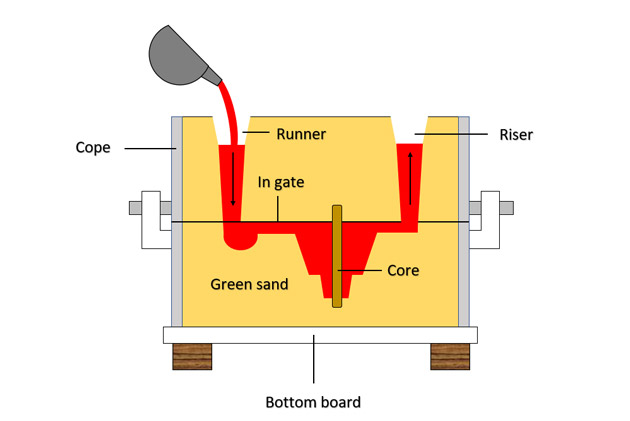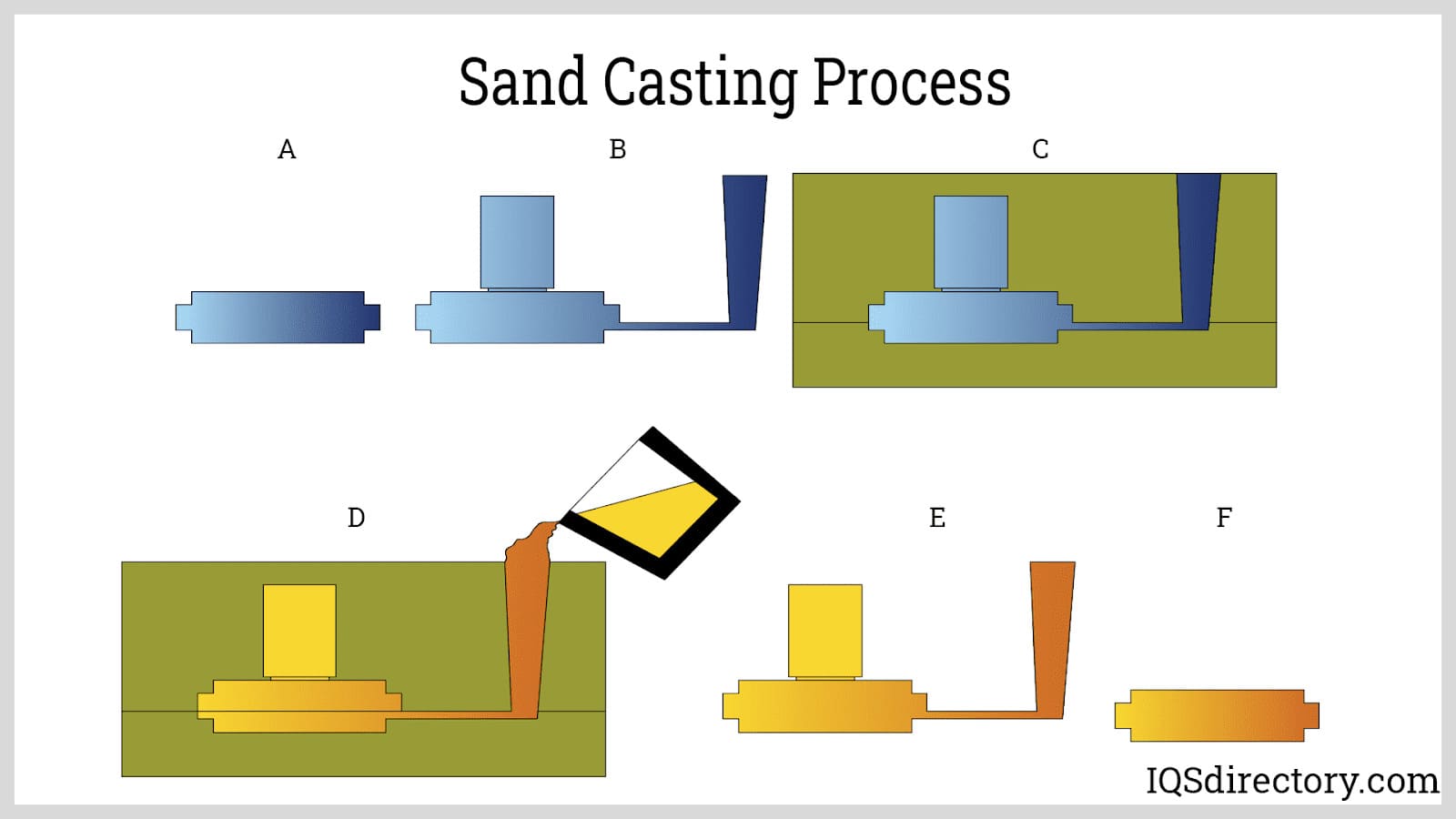Exploring Aluminum Foundry Wisconsin and its role in custom casting
Wiki Article
How Aluminum Foundry Adds To Innovations in Aerospace Design
Aluminum factories are integral to developments in aerospace engineering. They create light-weight, high-strength parts that are vital for contemporary aircraft. With innovative spreading techniques, these foundries develop intricate geometries that enhance structural stability. Furthermore, the advancement of exceptional Aluminum alloys supports the industry's concentrate on gas performance and sustainability. Obstacles stay in the production process. Understanding these aspects discloses the extensive impact of Aluminum on aviation's future.The Importance of Lightweight Materials in Aerospace Design
As the aerospace sector proceeds to develop, the significance of lightweight materials becomes significantly noticeable. The demand for efficiency and sustainability drives designers to prioritize making use of materials that reduce total weight without jeopardizing structural honesty. Lightweight products, particularly Aluminum, play an important role in boosting fuel efficiency, boosting payload capacity, and raising the general performance of aircraft.Additionally, the integration of these products permits ingenious designs, making it possible for makers to create even more wind resistant forms that can withstand severe problems. The decrease in weight not just decreases operational costs yet also adds to a decreased environmental footprint, lining up with global efforts towards sustainability in air travel.
Advanced Casting Techniques in Aluminum Foundries
Advanced spreading techniques in Aluminum foundries play an essential function in aerospace design by making it possible for the manufacturing of lightweight and precise parts. Technologies in mold and mildew design and precision casting procedures are essential in achieving optimal efficiency and structural honesty. In addition, the growth of light-weight alloys improves the general effectiveness and performance of aerospace applications.Innovative Mold And Mildew Design
Innovative mold layout plays an important function in the effectiveness and performance of Aluminum factories, especially within the aerospace field. By leveraging advanced materials and techniques, modern-day mold and mildews can be engineered to stand up to high temperature levels and stress, making certain peak performance throughout the casting process. These designs typically incorporate complex geometries that enable the manufacturing of lightweight yet structurally sound parts, essential for aerospace applications. Additionally, the usage of computer-aided layout (CAD) software program promotes exact modeling, allowing shops to improve and replicate mold layouts prior to physical production starts. This not only boosts the high quality of cast components however additionally decreases waste and preparation, leading to considerable price savings. On the whole, cutting-edge mold and mildew design is a keystone of progress in Aluminum Foundry modern technology for aerospace design.Precision Casting Processes
The efficiency of cutting-edge mold and mildew designs seamlessly integrates with precision spreading procedures, which are essential for producing top notch Aluminum parts in aerospace engineering. These processes, including sand casting, pass away spreading, and financial investment spreading, assure the creation of complex geometries with tight resistances. Advanced strategies like vacuum casting and pressure die casting boost the integrity and surface finish of the final items. Precision casting lessens material waste while optimizing the mechanical homes of Aluminum, vital for aerospace applications. Furthermore, using real-time monitoring and advanced simulation tools during the casting procedure permits for prompt changes, bring about boosted quality assurance. Jointly, these accuracy spreading processes setting Aluminum foundries at the forefront of aerospace innovation, sustaining the sector's demand for reliability and efficiency.Lightweight Alloy Advancement
As aerospace designers look for to enhance fuel performance and efficiency, lightweight alloy development comes to be an essential emphasis in Aluminum factories. These foundries employ innovative spreading techniques to produce alloys that offer exceptional strength-to-weight proportions. Advancements in alloy structure, including the unification of aspects like lithium and magnesium, allow the production of products that stand up to extreme problems while decreasing total airplane weight. Techniques such as die spreading and investment spreading assist in the precision manufacturing of complex shapes, which are crucial for aerospace applications. Additionally, ongoing research aims to maximize these alloys for enhanced mechanical residential properties and increased durability. By focusing on light-weight alloy advancement, Aluminum shops considerably contribute to the development of aerospace design, leading the way for extra effective and lasting airplane designs.
Enhancing Architectural Stability Via Aluminum Parts
Aluminum parts offer significant advantages in improving structural stability within aerospace engineering. Their lightweight nature adds to overall efficiency while preserving strength, which is vital for aircraft performance. Additionally, the anxiety resistance properties of Aluminum help ensure the toughness and reliability of aerospace structures under different functional conditions.
Lightweight Material Advantages
While conventional materials typically jeopardize weight for stamina, making use of Aluminum parts in aerospace engineering offers significant advantages in structural integrity. Aluminum's light-weight nature adds to overall layout performance, permitting for even more structured aircraft that consume much less gas, thus improving sustainability. The product's exceptional strength-to-weight proportion assurances that parts preserve sturdiness without adding unneeded mass. This quality cultivates boosted efficiency and dexterity in trip, as well as maximized payload capacities. Furthermore, Aluminum's resistance to deterioration prolongs the life-span of aerospace structures, decreasing upkeep prices and enhancing security. As manufacturers significantly take on Aluminum alloys, the aerospace industry experiences a transformative shift in the direction of a lot more effective and effective design solutions that prioritize both efficiency and environmental obligation.Tension Resistance Residences
Different materials possess special residential or commercial properties, Aluminum's remarkable stress and anxiety resistance stands out as a critical factor in boosting the structural stability of aerospace elements. This resistance plays a critical function in ensuring that aircraft can withstand various operational stresses, consisting of fatigue, effect, and environmental conditions. Aluminum alloys, especially engineered for aerospace applications, display high tensile stamina while keeping light-weight characteristics, allowing designers to create much more effective structures - Aluminum Foundry. Additionally, the ability of Aluminum to endure cyclic loading without substantial deformation adds to the Get More Info longevity and dependability of aerospace components. As improvements continue in Aluminum Foundry methods, the advancement of stress-resistant Aluminum parts promises further renovations in performance, safety, and effectiveness throughout the aerospace market, strengthening Aluminum's duty as a recommended product in modern-day designFuel Efficiency Improvements Driven by Aluminum Innovations
As the aerospace industry looks for to improve fuel effectiveness, innovative uses Aluminum have become a necessary remedy. Aluminum's light-weight nature significantly lowers aircraft weight, enabling for reduced gas usage during trip. This reduction in weight is important, as also tiny reductions can lead to significant renovations in total fuel economic climate.Advanced Aluminum alloys, developed for enhanced toughness and longevity, make it possible for producers to create parts that preserve architectural integrity while minimizing mass - Aluminum Foundry. Additionally, the combination of Aluminum in airframes and engine components facilitates enhanced the rules of aerodynamics, contributing to lowered drag and raised efficiency
The fostering of Aluminum in aerospace not only satisfies the need for fuel-efficient style yet likewise straightens with regulatory stress for reduced emissions. As these innovations proceed to evolve, they play a substantial role in establishing new criteria for gas effectiveness, guaranteeing that the aerospace field can meet expanding environmental and economic difficulties.

The Function of Aluminum in Sustainable Air Travel Practices
The increasing emphasis on sustainable aviation methods has actually placed Aluminum as an essential material in the pursuit for greener airplane layout. Recognized for its lightweight residential properties, Aluminum substantially lowers airplane weight, leading to lower fuel consumption and you can try these out emissions. Its recyclability even more improves its sustainability profile, as Aluminum can be recycled indefinitely without loss of top quality. This particular sustains a round economic situation within the aeronautics market, decreasing waste and source exhaustion.Additionally, improvements in Aluminum alloys have actually enhanced their strength and corrosion resistance, permitting for longer service life and reduced upkeep demands. These technologies assist in the development of extra reliable aircraft frameworks, adding to overall sustainability initiatives. Furthermore, Aluminum's thermal conductivity plays a critical function in energy-efficient layouts, improving systems such as heat exchangers. Jointly, these attributes emphasize Aluminum's critical duty beforehand sustainable aeronautics, lining up with global efforts focused on lowering the environmental influence of air traveling.
Difficulties Encountered by Aluminum Foundries in Aerospace Manufacturing
While Aluminum factories play an essential function in aerospace production, they face substantial difficulties that can impact production performance and high quality. One significant challenge is the rigid quality control criteria required in the aerospace market. Any kind of flaw can endanger security and efficiency, demanding rigorous assessment procedures that extend production timelines. In addition, foundries typically emulate fluctuating resources expenses, which can influence pricing and success. The complexity of Aluminum alloys utilized in aerospace applications more makes complex the manufacturing process, as exact solutions are crucial for accomplishing preferred mechanical homes. In addition, skilled labor shortages impede the capability our website to keep top quality manufacturing degrees. Lastly, ecological policies enforce limitations on discharges and waste monitoring, calling for shops to purchase lasting techniques, which can be cost-prohibitive. These elements collectively create a landscape where Aluminum foundries must continuously adapt to meet the developing demands of aerospace production while ensuring safety and conformity.Future Fads in Aluminum Applications for Aerospace Engineering
With advancements in modern technology and raising needs for efficiency, the future of Aluminum applications in aerospace design is positioned for considerable transformation. The integration of innovative Aluminum alloys and compounds is expected to boost strength-to-weight proportions, causing more fuel-efficient aircraft layouts. Additionally, innovations in additive manufacturing techniques will certainly permit for the production of intricate Aluminum structures that were formerly impossible, maximizing performance and decreasing waste.
Sustainable methods will certainly play an important function, with an expanding focus on recycling Aluminum to reduce ecological influence. The aerospace sector is likely to welcome smarter manufacturing processes, such as automation and expert system, making certain better and precision in Aluminum elements. Collaborations between Aluminum foundries and aerospace companies will foster research and growth, paving the way for new applications that fulfill the stringent requirements of modern aerospace design. On the whole, the future looks assuring for Aluminum's duty fit the skies
Regularly Asked Inquiries
What Are the Ecological Effects of Aluminum Manufacturing in Aerospace?
The environmental impacts of Aluminum production in aerospace include significant power intake, greenhouse gas discharges, and environment interruption. Additionally, mining procedures can bring about dirt deterioration and water contamination, raising issues about sustainability and eco-friendly balance.Just How Does Aluminum Contrast to Other Products in Aerospace Applications?
Aluminum uses a special combination of light-weight properties, deterioration resistance, and cost-effectiveness contrasted to other products. Its high strength-to-weight ratio makes it particularly advantageous for aerospace applications, improving gas performance and general performance in airplane design.What Qualifications Do Aluminum Foundry Employees Need for Aerospace Projects?
Aluminum Foundry employees need specialized training in metallurgy and spreading techniques, in addition to understanding of aerospace sector requirements. Certifications in top quality control and security methods are likewise vital to assure compliance with rigorous aerospace job needs.Exist Any Security Concerns With Making Use Of Aluminum in Aerospace Engineering?
Safety and security worries relating to Aluminum in aerospace engineering consist of susceptibility to fatigue, anxiety, and deterioration fractures. Correct therapy and alloy selection are crucial to mitigate these dangers, making certain architectural integrity and general safety and security in aerospace applications.How Does Aluminum Recycling Benefit the Aerospace Sector?
Aluminum reusing significantly profits the aerospace industry by minimizing product prices, reducing environmental effect, and preserving energy. This sustainable technique enhances the market's performance while advertising using light-weight, high-performance elements in airplane manufacturing.Advanced casting strategies in Aluminum shops play a vital function in aerospace engineering by enabling the production of precise and lightweight elements. Cutting-edge mold and mildew design plays a vital role in the efficiency and effectiveness of Aluminum foundries, particularly within the aerospace sector. As aerospace designers look for to improve fuel efficiency and efficiency, light-weight alloy advancement becomes an important focus in Aluminum shops. Aluminum alloys, especially crafted for aerospace applications, display high tensile strength while maintaining light-weight features, making it possible for designers to create a lot more reliable frameworks. Cooperations between Aluminum foundries and aerospace business will foster research and development, leading the means for new applications that fulfill the rigid requirements of modern aerospace design.
Report this wiki page